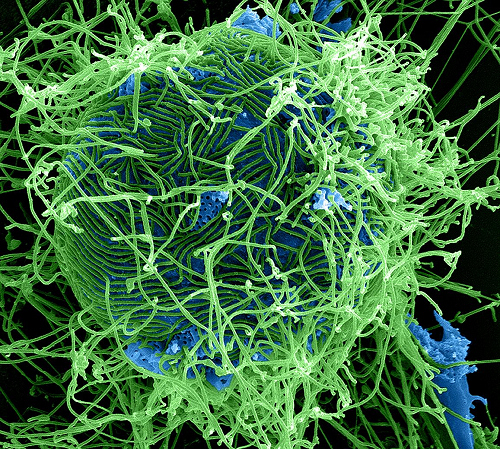Antibodies from Ebola survivor protect mice and ferrets against related viruses
NIAID-funded study could lead to broad, versatile treatments for many different Ebolaviruses.
The fight to contain the 2013-16 Ebola outbreak in West Africa was hampered by the lack of an effective treatment or vaccine. Researchers funded in part by the National Institute of Allergy and Infectious Diseases (NIAID), part of the National Institutes of Health (NIH), have studied the blood of an Ebola survivor, searching for human antibodies that might effectively treat not only people infected with Ebola virus, but those infected with related viruses as well. Now the researchers have identified two such antibodies that hold promise as Ebola treatments.

Colorized scanning electron micrograph of filamentous Ebola virus particles (green) attached to and budding from a chronically infected VERO E6 cell (blue) (25,000x magnification).
Previously, researchers had discovered only one antibody—from a mouse—capable of protecting mice against multiple different species in the ebolavirus lineage. To find similar broadly protective human antibodies, researchers surveyed 349 human monoclonal antibodies derived from the blood of one survivor of the recent West African Ebola outbreak, which was caused by Zaire ebolavirus. They searched specifically for antibodies that might neutralize all five common ebolavirus species.
The researchers mined the human immune response to natural infection by the Ebola virus and found two antibodies, ADI-15878 and ADI-15742, which recognized the GP fusion loop — a section of a protein found on the surface of the Ebola virus. By analyzing the structure of these antibodies and testing their action on the viruses, the researchers determined that when given access to the GP fusion loop, the antibodies could likely block the five related ebolaviruses from entering a host cell. Moreover, when tested with human cells in a laboratory setting, the antibodies protected the cells from becoming infected with several different virulent ebolaviruses.
To further investigate these findings, the scientists tested the antibodies in three animal models: wild-type mice, mice genetically altered to be susceptible to Sudan ebolavirus, and ferrets. Treating wild-type mice with the antibodies after exposure to the Zaire ebolavirus appeared to have a protective effect, as did treating the altered mice after exposure to Sudan ebolavirus. The ferrets experienced a protective effect from the antibodies after exposure to Bundibugyo ebolavirus.
However, in the ferrets exposed to the Bundibugyo virus and treated with ADI-15742, the virus developed a single mutation that enabled it to escape the antibody’s effects. In addition, neither antibody conferred protection against the related Lloviu or Marburg viruses when tested in human cells in the laboratory setting. Still, the researchers suggest that these broadly neutralizing antibodies could provide the basis for a candidate treatment, but further exploration is needed. These findings may help inform the development of therapeutic pan-ebolavirus antibodies, as well as vaccines for potential use in the event of another Ebola outbreak.
Source: U.S. National Institutes of Health
- 325 reads
Human Rights
Fostering a More Humane World: The 28th Eurasian Economic Summi

Conscience, Hope, and Action: Keys to Global Peace and Sustainability

Ringing FOWPAL’s Peace Bell for the World:Nobel Peace Prize Laureates’ Visions and Actions

Protecting the World’s Cultural Diversity for a Sustainable Future

Puppet Show I International Friendship Day 2020

